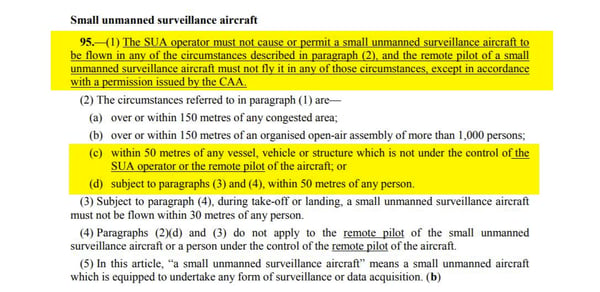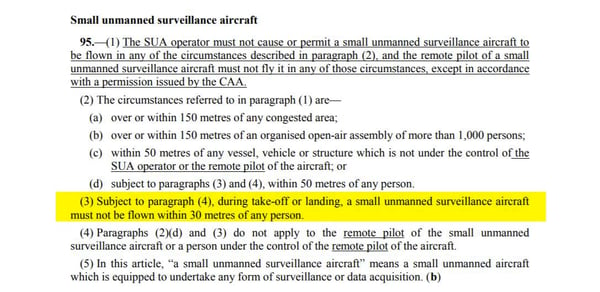Sometimes we get asked for reassurance about how close you can get to people and property with your drone and how do you get them under your control so you can get closer?
For people and structures that aren't under your control, it's quite straightforward. You have to maintain a 50m separation distance from people and property. This 50m is around your aircraft or another way to imagine it is an invisible bubble/shield around the person or structure that you can't penetrate.
This is in the CAP 393 Article 95 as shown and highlighted below:

During take-off and landing, you have to stay 30m away from people not under your control.

It's this control point that some people seem to (sometimes) be misguided by other people around what defines 'control'?
What Defines Control
The CAP 722 is our guidance and policy document for flying Small Unmanned Aircraft (Drones), and actually, we have to abide by it as per our PfCO (should you hold one).
On page 48 - 50 of the CAP 722 the CAA has outlined a clear definition of control using scenarios.
People
Persons under the control of the SUA operator or remote pilot can generally be defined as:
- Persons solely present for the purpose of participating in the flight operation.
- Persons under the control of the event or site manager who can reasonably be expected to follow directions and safety precautions to avoid unplanned interactions with the small unmanned aircraft. Such persons could include building-site or other industrial workers, film and TV production staff and any other pre-briefed, nominated individuals with an essential task to perform in relation to the event.
Spectators or other persons gathered for sports or other mass public events that have not been specifically established for the purpose of the flying operation are not regarded as being ‘under the control’ of the of the SUA operator or remote pilot.
In principle, persons under the control of the SUA operator or remote pilot at a mass public event must be able to:
- elect to participate or not to participate with the small unmanned aircraft flight operations;
- understand the risk posed to them inherent in the small unmanned aircraft flight operations; have reasonable safeguards instituted for them by the site manager and SUA operator during the period of any flight operations;
- not have restrictions placed on their engagement with the purpose of the event or activity for which they are present if they do not elect to participate with the small unmanned aircraft operation.
Note: As an example, it is not sufficient for persons at a public event to have been informed of the operations of the small unmanned aircraft via such means as public address systems, website publishing, e-mail, text and electronic or other means of ticketing, etc. without being also able to satisfy the points above. Permissions have, however, occasionally been granted for small unmanned aircraft flights at public events where these involved a segregated take-off site within the main event, with the aircraft operating only vertically within strict lateral limits that keep it directly overhead the take-off site. Such flights may also be limited by a height restriction and the tolerance of the aircraft to wind effects and battery endurance.
So a person under your control as the remote pilot will generally be anyone that's there for the purpose of the flight, so we can reasonably assume the client is. If you are flying on, for example a construction site, then you as the remote pilot or a designed site manager can brief people prior to the flight with an appropriate safety briefing.
If you are intending to fly at a public event then you cannot assume that everyone at the event (the public) is under your control and the people must be able to elect to participate or not participate within the drone operations area. You cannot just use a public address system to 'assume' that the persons are under your control.
Structures
On page 50 of the CAP 722, the document clearly states that
A structure could be said to be ‘under the control’ of a person if:
- The owner or other person with an interest in the structure (such as a lessee) has granted permission for a UAS to operate within 50 metres of that structure; and
- Any occupants of the structure are under the control of the remote pilot.
So you have to make sure that the owner or whoever has an interest in the structure (whomever primarily leases the building) has granted you permission to fly within the 50 metres of the building but, but also, any and all occupants of the structure are under control of the remote pilot.
So let's take the scenario that a company wants a promotional shot of their own building and they employ all of the staff. A nominated manager at the building can ensure that all people inside are aware f the flight and are correctly briefed, or it can be done by the Remote Pilot. Then you could fly within 50 metres of the building.
If the building is a block of flats then you would have to get 'control' of everyone inside the building, even if you had permission from the building owner. In this case of control let's go back to
- Persons solely present for the purpose of participating in the flight operation.
- Persons under the control of the event or site manager who can reasonably be expected to follow directions and safety precautions to avoid unplanned interactions with the small unmanned aircraft.
You cannot assume that everyone in that block of flats is under your control because how can they be reasonably expected to follow directions and safety precautions if they aren't aware of what they are?
Conclusion
Make sure that you are maintaining 50 metres away from people and structures not under your control. To get control you need to have done an appropriate safety briefing (or if on a site then a nominated person such as a site manager can do this).
You cannot assume the someone is under your control if they don't have the oppurtunity to elect to participate or not participate within the activity of the drone.
If you are still unsure of that you can or cannot do with your aircraft then check out this video here and subscribe to the Mr MPW YouTube channel for daily information on staying safe wthin the industry.
If you are interested in getting your PfCO from the CAA then get in contact with the team today on 01491 526 700 or check out this page.



